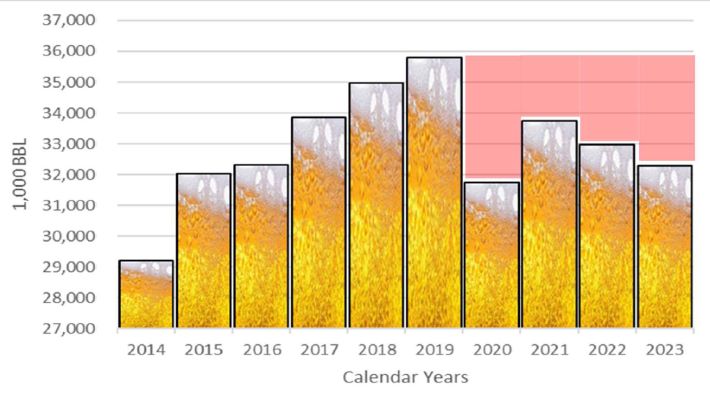
2) How Fair State Brewing Hit Bankruptcy, and How It Plans to Fight Through It
3) Craft Beer Has Been Flat for Eight Years, and Other Notes
4 What we’ve gained and what we’ve lost in a decade of British beer
The first story is behind a paywall, but I found a way around it and you may as well. If not, OK, because in the second, Fair State co-founder Evan Sallee does a better job of answering the question anyway:
“Even talking about a “craft beer bubble” has been a pet peeve of mine. Craft beer is not a bubble; bubbles are a special thing where prices are inflated, and disconnected from the underlying market. Whereas the growth of craft beer has been driven by a consumer demand revolution. There are a lot of breweries competing for limited consumers, but that does not a bubble make.”
The chart at the top draws on slightly different data than Jeff Alworth uses in No. 3. John I. Haas CEO Tom Davis shared it at the American Hop Convention. It tracks production from Brewers Association defined craft breweries plus brands once classified as craft that are now owned by large breweries. The pink on the right represents barrels of beer that would have been sold had sales simply gone flat in 2020, rather than declining, not completely recovering, then declining again. Obviously, that matters a lot to hop growers. When barrels aren’t brewed then hops aren’t used. In this case, about 20 million pounds of them.
Two thoughts. First, indeed, little difference between production in 2015 and 2023. Second, if you draw an arrow from the top of the bar at 2015 to 2019 it looks much different than an arrow drawn from the top of 2019 to 2023. Production might be the same, but something different is going on.
Finally, I haven’t seen figures that compare British craft production in 2015 and today, but Boak & Bailey’s then and now illustrates what happens over time. Additionally, it is a reminder of how beer blogging has changed. This is the sort of post that 10 years ago would have inspired more of the same.
What would you pick from 2014 to pair with thiolized yeast, with hop water, with 19.2-ounce cans?
You might also enjoy
– How Does a Brewery Move Forward After a Racist Incident?
More out of the Twin Cities. “56 Brewing is still navigating the ramifications of the incident nearly three years on. (Their) story of moving forward with purpose and success in an unforgiving digital landscape is a sound roadmap after a devastating incident.”
– Does European beer have an American flavour?
If so, shouldn’t it be spelled “flavor?” Anyway, the premise: “Last year, through a combination of luck, obligation and planning, I managed to visit a random selection of bars and breweries in some of Western Europe’s major and major-ish cities (Copenhagen, Paris, Barcelona, Berlin, Brussels, and Glasgow). In and of themselves, they’re not particularly interesting; as a set, they arguably illustrate some different ways in which craft beer has landed in related but different cultures.”
– This Is Senne’s Valley
“I really dislike if your aroma and your body don’t combine together,” says Senne Eylenbosch, talking about blending. “If it’s too fruity in the nose, and it’s too slow-drinking in the body—because body is also one of the reasons that something is very slow drinking—it fights. It’s not good when the aroma is not in character together with the body.”
– Homebrew – Cheaper than the Pub?
Plenty of math in this post. “One thing though that is really clear to me from this little exercise is that ingredients are not the bulk of the cost of making the beer, it is a the people, equipment, and place to do so.”
I don’t have a lot of time for arguments like “the growth of craft beer has been driven by a consumer demand revolution” as there is simply no basis for it. Hype is largely a producer driven and as it turns out it’s a strategy that has become stale dated for many consumers. Your observation on the chart including coopted macro-craft is spot on and, as you say, the beers in that pink space are duller shadow craft. Grocery store brands that project cool but don’t challenge all that much. But a rational price and character point in the overall market. Who lives there? Sensible people who like the beer but can’t be bothered paying a premium for hype? Did tail chasing craft forget about that segment?
How about if we remove the word “revolution” and go with drive by consumer demand?
My opinion is that what has happened the last 40+ years has been driven by underlying demand. Yes, there is hype layered on top of that. So the question at the moment is what is real demand and what is hype. So perhaps there is a bubble that has burst. What if those sales have shrunk 5 or more million barrels. That would mask growing demand for non-hype beers.
I think if there was a primary consumer demand for better beer once, well, it lost its primacy starting maybe +/- ten years ago. Now that demand is split up, what with greater movement in consumer interest towards a lower price point, less caloric, less bombastic and less alcoholic offerings. It’s all about having less of something in the glass, less of that craft beer promise. I don’t see any cause yet to believe that the core premium craft beer market has deflated fully yet. I still expect to see someone trying to sell a hopless hop water.
You mean like NA hard seltzer?
There are many paths to the destination! 😉